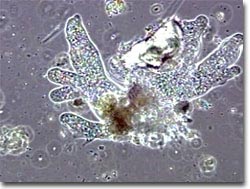

Typically, what happens in classical conditioning is that "an association is formed between a non-significant or neutral stimulus (the spherical shape and color of a lemon) ... and a biologically significant stimulus (citric acid)... When the neutral stimulus (the CS) reliably precedes the biologically significant stimulus (the US) we come to respond to the CS in a way that is different from the way we used to. In other words, we have established a CR ...[T]he innate reaction to citric acid (salivation) ... [is] ... the UR" (Abramson, 1994, p. 124).
Instrumental and operant conditioning are generally defined as "the control of behavior by its consequences" (Abramson, 1994, p. 152). For instance, a "rewarding" consequence such as food can be used to control behaviour by an animal, such as pressing a lever.
It has been claimed that paramecia possess a capacity for learning through classical conditioning. The original experiment was reported in a study by Hennessey, Rucker and McDiarmid (1979) and is still widely quoted (e.g. by Martin and Gordon, 2001). However, according to a mail archive message by Dr Paul Brandon, who was associated with the original study, there are strong grounds for doubting the results:
Actually, I have some doubts about that study, since it was done in our department and I was helping with it. The main observation was done by Todd Hennessey, a grad student of Bill Rucker's. Since it was a somewhat subjective judgement call on the movement of a paramecia (sic) in response to a stimulus (vibration -- a microscope slide was mounted on a speaker cone) I suspect a strong demand effect. As far as I know, this study was never replicated (Brandon, 2001).
In accordance with the methodological principles laid down earlier, I shall not consider this evidence. Since there appear to be no other studies that include appropriate control conditions (Steele, 2001), the ascription of associative learning to paramecia would appear to be unwarranted.
Hinkle and Wood (1994) also dispute the existence of associative learning in protozoa. In their study, they examined a claim that the protozoan Stentor exhibited a form of instrumental conditioning while learning to escape from a capillary tube over repeated trials. In a recent personal email communication, Wood (personal email, 18 June 2003) writes:
Our results indicated this phenomenon is not a real example of instrumental conditioning (Hinkle and Wood, 1994).Back to Protoctista References *** SUMMARY of Conclusions reachedI also know of no other well substantiated cases of associative conditioning in ciliates.